ASUS PA246Q 24" ProArt Monitor: No Adjustments Needed?
by Chris Heinonen on July 2, 2012 1:30 PM ESTASUS PA246Q - Color Quality
ASUS promises a dE < 5 out of the box with their sRGB and AdobeRGB modes, but do they deliver? Well, yes and no. The problem with this promise is that you have to decide how you are going to measure dE for the display. Do we just measure the dE for white, or grayscale, or grayscale plus the primary colors? Or should we measure the full Gretag Macbeth color checker chart and expect a dE below 5 there? Also, should we use dE 1976, 1994, 2000, or something else? Since none of these are specified, I am unsure how to judge ASUS, other than against other monitors with our standard GMB testing.
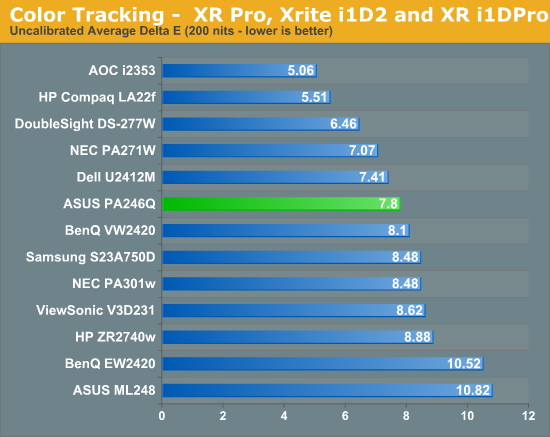
Out of the box in sRGB mode we see that performance isn’t any better or worse than other displays for the most part. However the grayscale is overall very good, and the primary colors are decent for the most part with dE values that are relatively low. If I’m judging the <5 claim based on this, the PA246Q might live up to expectations. Once I move into certain shades of blue, however, the dE really gets high, and so using the whole spectrum I can’t say that it manages <5 dE for the sRGB mode. Perhaps they are using a different dE formula than we are, or perhaps they are only claiming that white will be below 5, but using the same standard we apply to other vendors, the PA246Q isn't any better or worse out of the box than the competition.
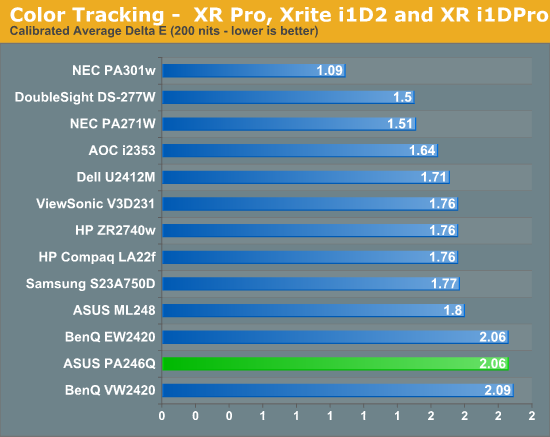
So out of the box the calibration seems fine but not exceptional, but does it calibrate well for those that need it? Overall the calibrated dE of 2.06 looks a little high, but when we examine the graph we see that the grayscale is much higher than any other display in the chart. This is a bit weird, and leads me to wonder how well the two-point grayscale calibrates and is handled internally. I set that for 100% and 30% as those should lead to a fairly accurate grayscale across the gamut, but here it seems to be good at 100% and then really ramp up. If the math is incorrect internally, this could lead to these issues where it has those two points correct, but determining the values for points between them is done incorrectly.
When I broke out the data more, the average dE for the color patches was 2.08 for the ASUS, which is almost equal to the overall value. For other monitors I had data for, the colors were on average 0.25 dE higher than the total dE with grayscale. So it seems that colors are better on the ASUS, but the grayscale is worse. In this case if you are doing photo editing, it might be a better choice than if you are using it for black and white work or even general-purpose work. With spreadsheets and word processing, you don’t notice a tint since the white is very good overall, but dark shadows can be off. So overall the performance of the ASUS PA246Q here was good for color and fairly poor for grayscale, which is different than almost any other display we have seen.

With 100 nits, the grayscale was much better and so the better colors led to a dE that was lower than with 200 nits. Because of this the ASUS seems to be a better performer for print work than for brighter rooms, but really the main area it fails is for black and white photo editing with a brighter screen.
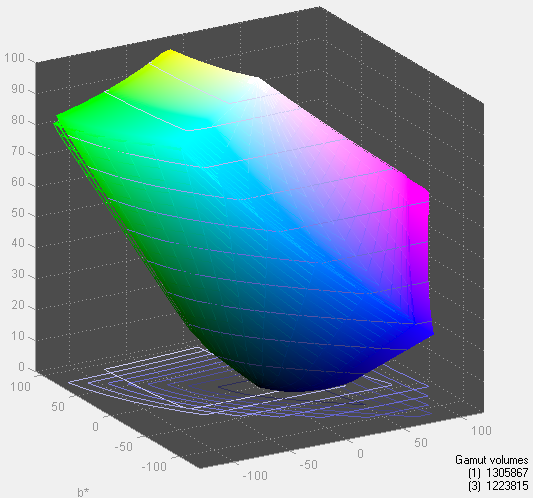
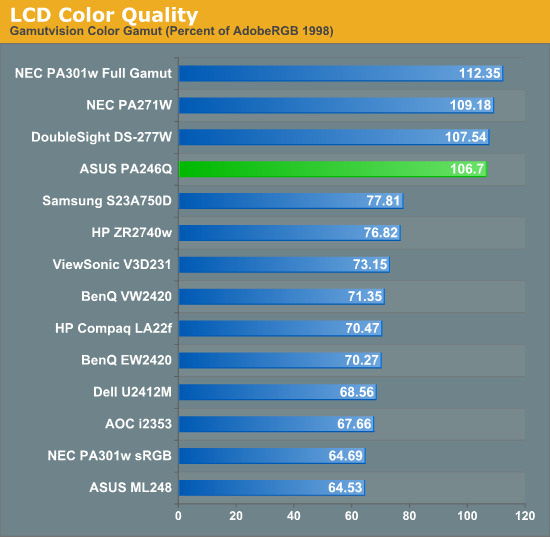
ASUS says they can do the full AdobeRGB gamut on this display and they aren’t lying. With almost 107% coverage it will work well for photographers and other professionals that need the larger gamut.


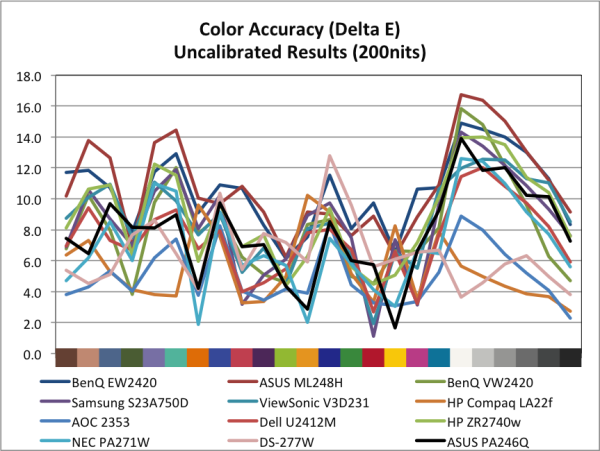
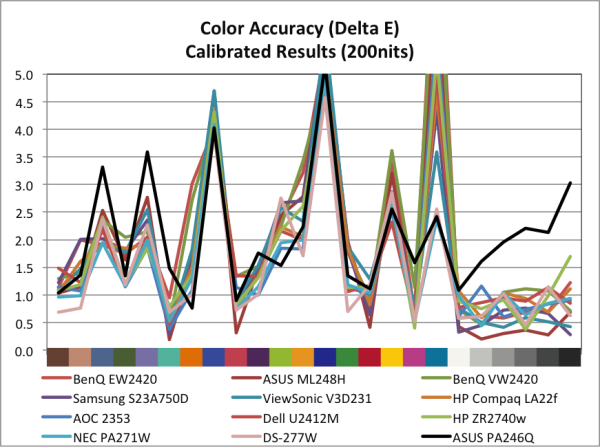









52 Comments
View All Comments
cheinonen - Monday, July 2, 2012 - link
The PA246Q had already been requested, and arrived, when the PA248Q was announced. It also an sRGB monitor as opposed to AdobeRGB, so a better comparison for it might be the Dell U2412M, whereas the PQ246Q competes with the Dell U2410. Using such a similar model number is annoying, but really they're complementary products and not competitive ones.Leyawiin - Monday, July 2, 2012 - link
Yep - its coming to market late this month (and I think I'm going to pop for one at that price).Spoogie - Monday, July 2, 2012 - link
There are serious quality control issues with this model. On my second one in six weeks. 1) humming noise, 2) flickering, and 3) goes blank randomly for 1-3 seconds. The first one did both one and two, the second one has all three problems.I'd return it if I wasn't past the 30-day return window.
aranyagag - Tuesday, December 11, 2012 - link
mine was perfectDevo2007 - Monday, July 2, 2012 - link
It appears you are missing the results for this monitor in the "Calibrated for Print Average Delta E" graph..cheinonen - Monday, July 2, 2012 - link
Sorry about that, fixed it now, not sure how it got left out.funkforce - Monday, July 2, 2012 - link
Fantastic review! Even better than many on sites dedicated to TFT-reviews only.I hope there are a lot more of these to come and I would really like to see more on:
What progress has been made in the last years and what are the top monitors in each field/technology today for non-pro users?
(PVA/MVA/AMVA vs. IPS/eIPS vs. TN technology/best in class.)
What would be the best non-TN panel for gaming today?
Does performance differ a lot on the HDMI and DVI-output on the same panel? (In cases where both exists)
Would it possible to manufacture a LED, 120hz, IPS/VA, 2560x1440, with minimum input lag, near accurate colors and good blacks in the near future?
Will OLED make this a reality?
On most comparison sites for shoppers there are a lot of customer reviews that are mentioning problem with backlight bleeding on most IPS panels.
It would be awesome if you could get an extra retail sample of every monitor you review to see if there's a big difference between to identically named panels.
(I know a guy that bought two would be identical LG screens from the same store where one was manufactured in China and the other in Poland and they differed a lot).
Although I understand if it would be an unreasonable wish.
I just bought a LG IPS236V and it has some backlight bleeding in both the lower left and right corner. It has a gamma setting that goes from 1.8-2.6 where the default 2.2 and above unfortunately only emphasizes the problem. Only the very bright setting of 1.8-2.0 (lower is brighter) result in very little bleeding but blacks are not so dark as one would wish.
It has several options greyed out, like black level and white balance no matter if you use an HDMI or DVI Cable. Is this normal and do you see it on lot of screens during your reiviews?
Many thanks in advance!
funkforce - Monday, July 2, 2012 - link
You can disregard my last question about the white balance and black level. Totally missed that page in the manual about it only being available on DSUB and HDMI.rickon66 - Monday, July 2, 2012 - link
I applaud them for building a computer monitor 16:10 and not a TV set 16:9. Thank You ASUS!Any monitor larger than 23" @1080p = FAIL!
Olaf van der Spek - Monday, July 2, 2012 - link
Right. 4:3 @ 1920 x 1440 or 2048 x 1536 would be even better. :p